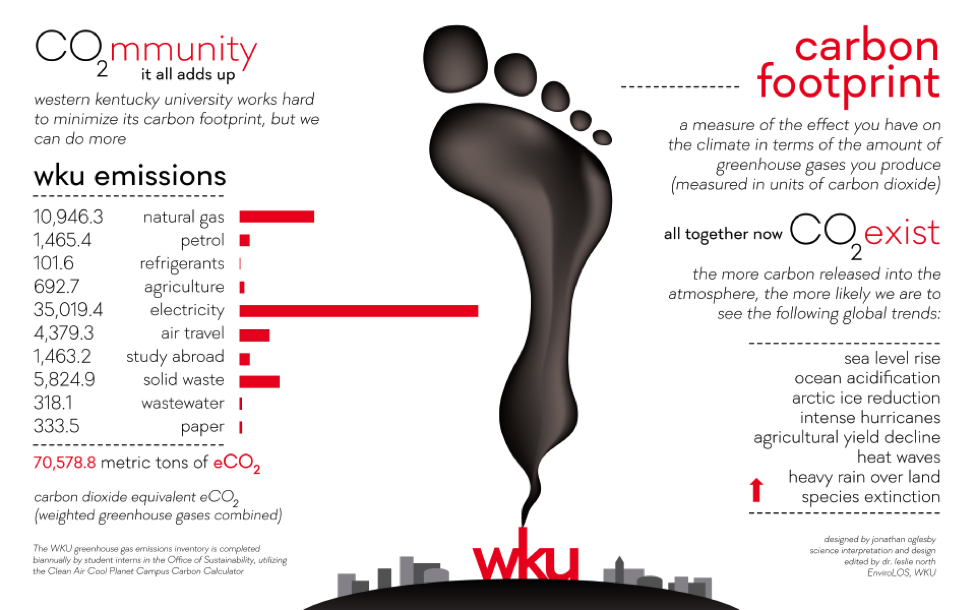WKU Office of Sustainability - Carbon Footprint
WKU's Carbon Footprint

Measuring our carbon footprint.
A carbon footprint is a measure of the impacts that our activities have on the environment, and in particular, climate change. We can measure our personal carbon footprint fairly easily, using an online calculator or carbon footprint tool. Our personal carbon footprint is impacted by the many choices we make in our daily lives, like the method of transportation we use, how much and what kind of energy we use in our homes, the foods we eat, and what we buy and throw away.
Specifically, a carbon footprint is a measurement of all greenhouse gases we produce, expressed as metric tons of carbon dioxide equivalent (MT eCO2). A carbon footprint can be assessed by performing a greenhouse gas emissions inventory. For an organization such as a university, it is much the same as for an individual; WKU’s carbon footprint is influenced by the type and amount of energy we use, the things we buy, our transportation uses, and what we throw away. Once our emissions inventory is determined, we can develop a strategy for reducing our carbon footprint.
Conducting a comprehensive greenhouse gas emissions inventory for a university campus is a big endeavor. Data must be collected and interpreted for everything from energy use to air miles traveled for university business to type and amount of paper purchased to how many cows and horses we have! We have been working to collect data for our greenhouse gas emissions inventory since 2009, and in some areas have a more complete inventory than others due to availability and completeness of data. We are pleased to share those elements of our carbon footprint for which we feel confident about our data.
Scope 1: Scope 1 sources are our most direct sources of emissions, and include on-site combustion of fossil fuels, such as the natural gas burned for heat and fuel used in vehicle motors.
Scope 2: Scope 2 includes purchased electricity. Our electricity is generated by the Tennessee Valley Authority, and their power generation profile looks like this:
(graphic)
Scope 3: Scope 3 sources include: faculty, staff and student commuting and air travel emissions and emissions associated with solid waste and waste water treatment, among many other things.
As we continue to study our campus carbon footprint, we will better learn which actions and choices make the most sense and gain insight as to how to be a more sustainable WKU. We encourage you to measure your own carbon footprint to learn how you can live more sustainably too.
The Office of Sustainability is pleased to share the results of our campus carbon inventory efforts. Please note that these are estimates based on imperfect and limited data. For scope 1 and scope 2 emissions, the inventory is limited to the activities and services of the main campus.
EPA Greenhouse Gas Reporting Rule
In October 2009, the EPA issued a Mandatory Greenhouse Gas Reporting Rule that requires reporting of greenhouse gas emissions from large sources and suppliers in the US. It is intended to collect accurate and timely emissions data to inform future policy decisions. Under the rule, suppliers of fossil fuels or industrial GHGs, manufacturers of vehicles and engines, and facilities that emit 25,000 metric tons or more per year of Scope 1 GHG emissions are required to submit annual reports to the EPA.
-For more information visit: EPA: Greenhouse Gas Emissions

